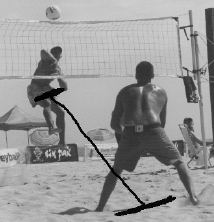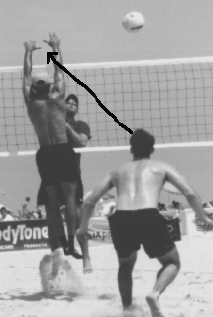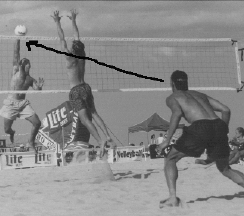How To Play Defense with a Block Up
Playing defense behind a blocker is a skill that requires tremendous patience.
The best blockers on the beach will get beaten by the hitter at least
80% of the time.
Realize this, and you will be a better defender, for you will know
that the ball is going to either go around, through, over, or under
the block most of the time.
That means that you are going to see lots of balls hit the sand all
around you, so if you are expecting to get most of them you are going
to be badly disappointed.
If you can dig 2 hits out of 5 (that’s 40%) you will be one of
the best defenders on the beach, and, for perspective, you can relate
this to being a good hitter in baseball, one who only gets a hit 1.5
times out of 5 at bats.
What is the blocker’s job?
To stuff block any ball he can, but since that doesn’t happen
all that often, his real job is to make the hitter hit the ball to
you or, even better, roll the ball to you.
What is the defender’s Job?
To get the ball up in a way that the blocker can then set him.
Sounds easy enough, right?
I once had a coach tell me that there is enough room on the other
side of the court to land a helicopter, of course, he then wanted to
know why I couldn’t get the ball to land on just one of those
900 square feet.
Your job is to make sure that the ball doesn’t land on one of
those 900 square feet, and that’s alot of square feet.
In the how to block article one of the most important things we
stress is to wait, wait, wait!
Well, guess what we are going to tell you is one of the most
important things to do when you are defending?
Yep, Wait, Wait, Wait!
You can’t get to a ball if you are going the wrong way, and if
you think you can anticipate where the hitter is going to hit the
ball to, you are in for a surprize.

Perfect Position
Just Inside Block
But Anticipating and Guessed Wrong!
Don’t anticipate, react when the hitter hits the ball.
Even if you are not where you would like to be on the court when the
hitter hits, Stop and get into the ready position.
To be in the ready position, you should be standing still, weight
evenly balanced on the balls of both feet, knees bent, with your toes
pointing in (slightly pigeon toed describes it well), and as low as
is comfortable for you, when the hitter hits the ball.
This stance allows you to go in almost any direction with equal ease
and try to get to a ball.
You want to be as far back in the court as you can while still not
giving the hitter the chance to just constantly bounce the ball in
front of you.
Why do you want to be deep in the court?
-
It makes it difficult to roll the ball over you.
- It is easier to go forward than backward.
- You give yourself more time to react, and with a hard hit this
can be most important in not getting six packed.
A very wise player once told me, “Never let them beat you deep!”
Why? Because you have a chance on the ball in front of you, but not
on the one that’s over your head.
OK, now you know that you want to be standing still as the hitter
hits the ball, but, where should you be standing?
If you and the blocker have decided that he will be blocking cross
court, you want to be standing about 3/4 of the court deep and in a
position to take away the cross court hit that would be just inside
the blocker’s block.
This is the position many refer to as “playing behind the
block” and results in your taking away the hard driven hit into
the middle of the court, which for many hitters is their best hit.
Now, comes the tricky part, which is to watch the hitter and try to
pick up cues as to where he is going to hit the ball.
Many players, when they are going to roll the ball, will drop their
hitting hand down to around their ear before they hit.
If you see this, you want to get ready to take off and chase their
shot down.
Almost all players will hit the ball on a line very close to
perpendicular to their hips & shoulders, which is why you want to
watch their approach and then get in front of them before they hit.
(See Picture just below)

Good Ready Position & Directly in Front of Player’s Shoulders
You want to make sure you can see the ball and the hitter or you will
have virtually no idea where the ball is going to go!

Too Far Behind the Block
Can’t See the Ball at Impact
In the picture above, the digger is too far behind the block and
cannot see ball or the player’s arm swing.
Therefore, he has much less time to react because he must wait for
the ball to come past the block before he can pick it up visually.
In the following pictures, you will notice that the digger has an
unobstructed view of the hitter, the blocker, and the ball making it
much easier to react.

Digging Cross Court
Notice the Blocker has “Channeled”
the Hitter to his Partner
It does not matter whether the blocker is blocking line or cross
court, you want to be able to see the ball.
If you can’t see the ball it means that you and the block are
covering the same part of the court, giving the other team even more
area to hit the ball to.
The only exception to this is when your partner stuff blocks it!
You will notice in most of the pictures in this section that the
blockers are blocking with their arms straight up and down and their
hands close together.
This results in the hitter seeing the block early and easily and
deciding to hit to the open area of the court which is where their
partner is standing, ready to dig the hit.
The blocker must believe that his partner will dig more balls if he
doesn’t get “Tooled” (small touches that deflect the
path of the ball away from his partner).
The pictures on this page are of JSVBA Open players and for most of
these guys it took a long time, good coaching, and lots of practice
to be able to read the hitters well enough to get in front of them
and be ready.
It also requires having played with their partners enough to be able
to predict what their partner was going to do.
You will notice, in the picture just above, that the blocker has
jumped slightly to his left but not so far that he is then between
his partner and the ball.
If he expected to stuff block the hitter he would go for the ball,
but, as you can see, he has made the correct decision, that the
hitter would get it by him anyway, and he would only obstruct his
partner’s view.
A great block can be one where you never touch the ball, but the ball
goes directly to your partner.

Digging the Line Hit
Good Position Just Inside the Block
Good View of the Hitter and Ball
Blocker Forces Hitter to Hit to His Partner
On Roll Shots, you just have to try to catch up to the ball.

This Hitter is Hitting a Roll Shot
When You See his Wrist Turn
You Should Take Off to Get the Shot
Like the Defender in this Picture
If the blocker has “Scared” the hitter into hitting the
ball just a little bit higher, like the player above has done, you
stand a good chance of being able to lay out (get horizontal) and get
a hand on the ball.
The more touches, the more points you score. |





